Despite winter being a favorite time of year for many, the doom and gloom of it all can be quite depressing. Many plants struggle to do well or simply just die back, leaving us with colorless gardens.
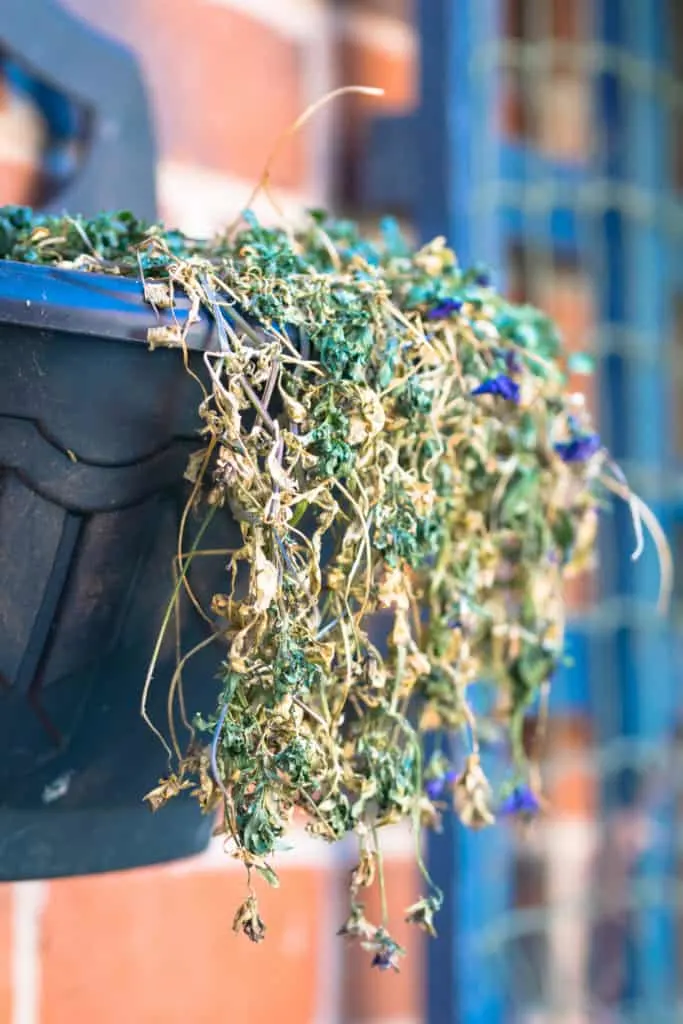
But there is one sure-fire way to add a splash of color and uniqueness to your space – hanging baskets filled with winter plants.
Hanging baskets are great ways to grow plants in small spaces, indoors or on patios and balconies.
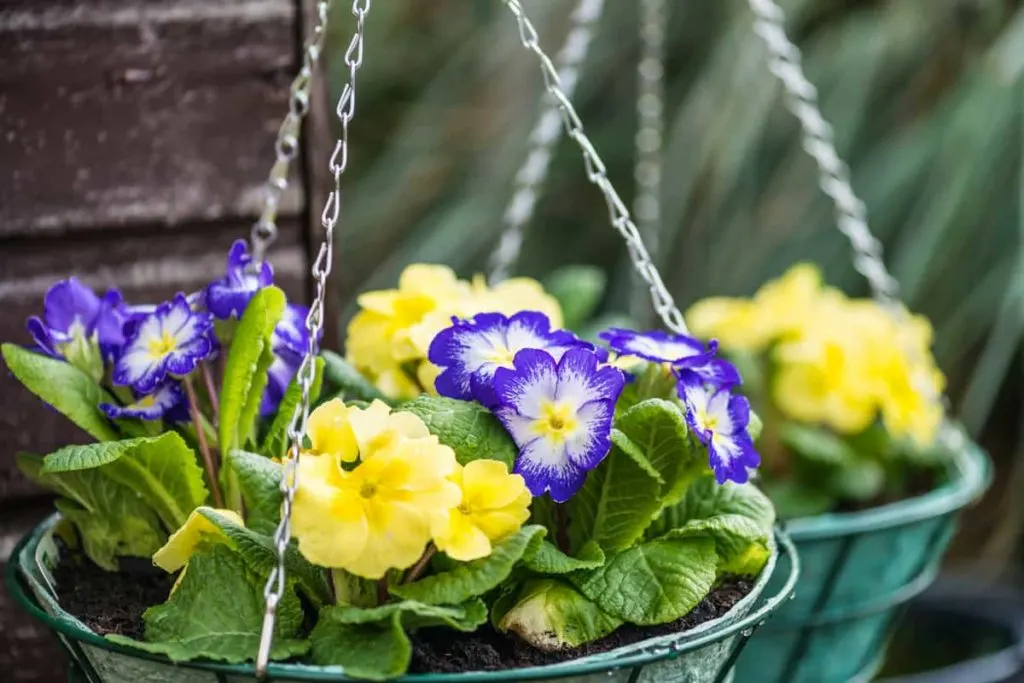
There are several winter plants out there that spread touches of summer during colder months. Many can survive the harshness of winter and some even have winter-busting superpowers.
This list is filled with plants that not only look great in hanging baskets but can break through the winter gloom with their colored foliage or brilliant flowers.
1. Pansies/Violas
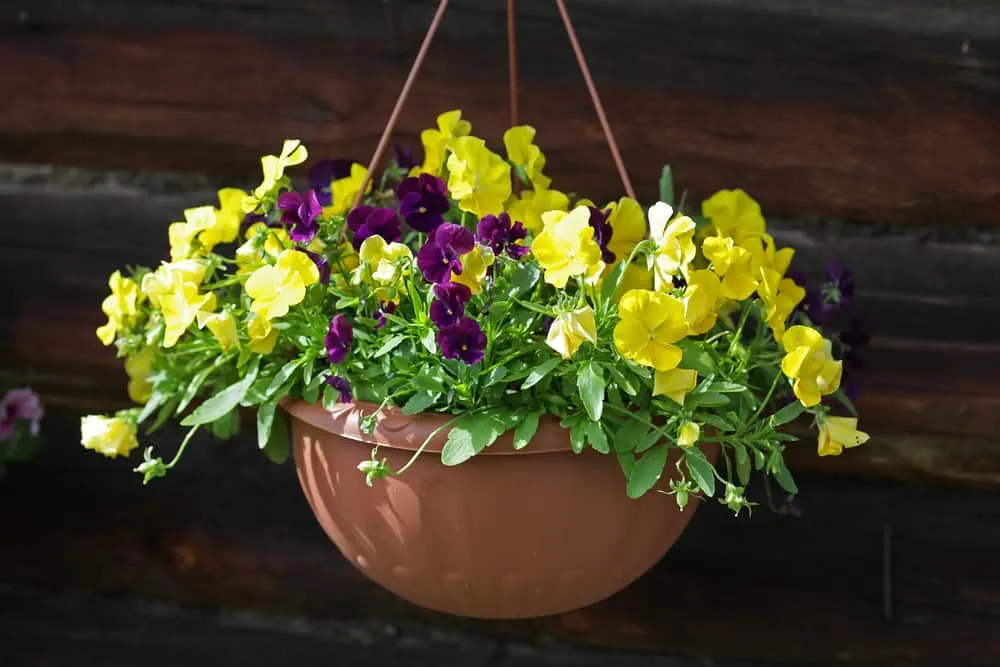
The perfect plants for colorful hanging plants are pansies and violas. Both these plants are amongst the easiest plants to grow and are often planted as filler plants in beds or containers. But their brightly colored flowers can stand out on their own, making them wonderful basket plants.
Pansies and violas are very similar, both thriving in full sun, and barely tolerating the shade. The main difference has got to do with their flowers. Violas have smaller flowers than pansies, but a lot more of them. Their colors are very similar too, ranging from blues to purples and even whites and creams.
To get the most out of these annuals (or short-lived perennials) plant them in compost-enriched potting soil and water frequently. They’re hungry plants, needing fertilizer at least once every four weeks. A balanced fertilizer ensures the most blooms, and if you want even more splashes of colorful flowers, opt for a low nitrogen mix.
Pansies and violas are also edible. Not only will you be adding warm summer colors to your hanging baskets, but also to delicious winter dishes.
Approximate size: 4 – 8 inches
USDA hardiness zone: 7 – 11
2. Cyclamens
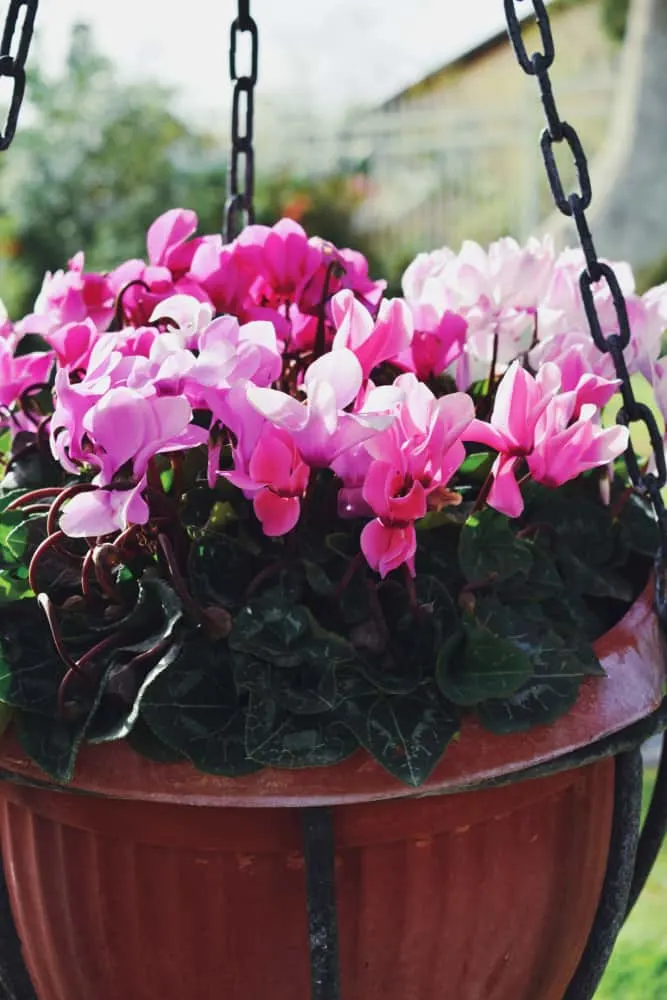
These little tuberous perennials are a go-to for small containers and shadier spots under trees because they add splashes of summer in even the dullest winters.
Cyclamens’ sweet flowers come in an array of colors, including red, white, pink, and even salmon. Newer varieties come in even more colors like purple and yellow-green and are showcased as ruffled double flowers. The flowers are perched on stalks that grow to about 12-16 inches tall which are surrounded by deep green, heart-shaped leaves.
Cyclamens are popular small houseplants, namely because they’re not fans of the heat and much prefer the shade. Their unusual trait of blooming during winter makes them a wonderful choice to warm up your indoor space or shaded balcony during the gloomiest of winter days.
With this cool characteristic though, they do unfortunately die back during summer. But you can simply cut away all the foliage and pop your baskets in a cool dry place and pay them no mind. Come the cooler months, your cyclamens will start regrowing and be ready for some water and a bit of fertilizer.
Cyclamens thrive in potting soil rich in compost that drains well. Root rot is a concern with these plants so water just below the leaves and allow all the water to drain thoroughly. Only water when the soil feels dry and don’t get any water on the foliage.
Approximate size: 6 – 16 inches
USDA hardiness zone: 5 – 9
3. Ivy
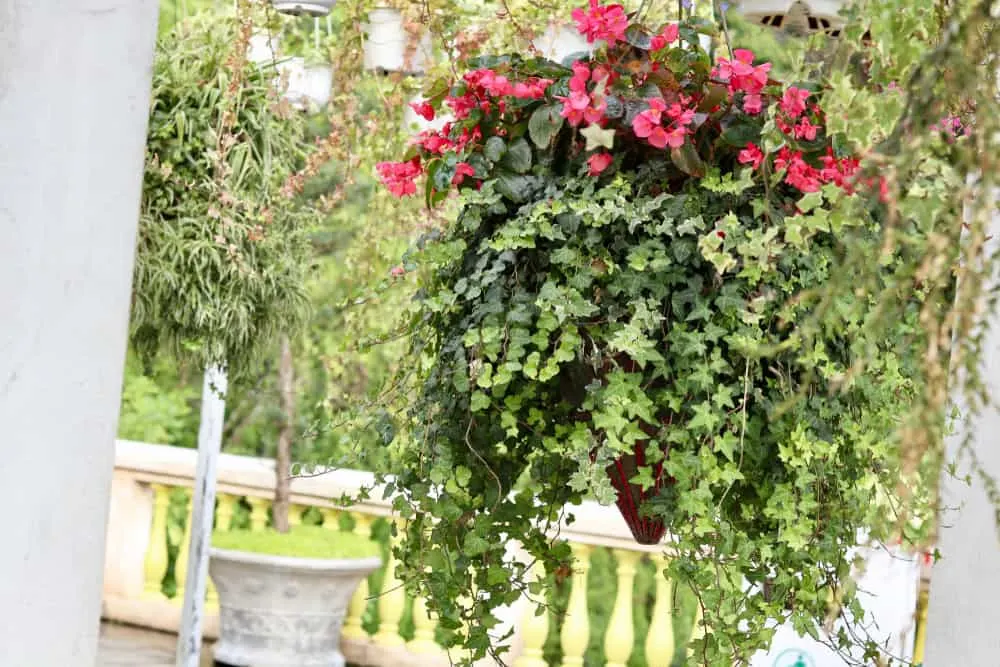
Ivy is usually seen as a run-away creeper that’s left to trail wherever it wants to go. Depending on where you live, it may be considered an invasive plant that needs getting rid of in beds. But, their creeping nature is what makes them such alluring basket plants. Their long vines flow over the edges of baskets, adding a waterfall of green throughout the year, even in the middle of winter.
There are several varieties of ivy to grow in your hanging baskets, including English ivy and Swedish ivy. The former has lobed leaves that range from light green to dark green. Swedish ivy on the other hand has quaint green leaves with white borders. English ivy is usually grown outdoors, but in shaded areas, while Swedish is predominantly a house plant. Either way, they’re both perfect for your winter hanging basket.
Plant your ivy in a good potting mix with good aeration and that drains well. Keep your basket in a shaded area that gets dappled light as these plants thrive in the shade. They’re also not fans of fluctuating temperatures and prefer a steady temperature range between 45-80F.
You’ll only need to fertilize your ivy twice a month (once every two weeks or so) during the growing season. Use a balanced fertilizer, adjusting only if you want your ivy to bloom. If that’s the case, use a low-nitrogen fertilizer.
The only other maintenance you’ll need to worry about is pruning if you want to control the flowing vines. Always use clean, sharp pruning scissors when trimming away any excess length.
Approximate size: Up to 15ft long, depending on the variety
USDA hardiness zone: 4 – 9
4. Ferns
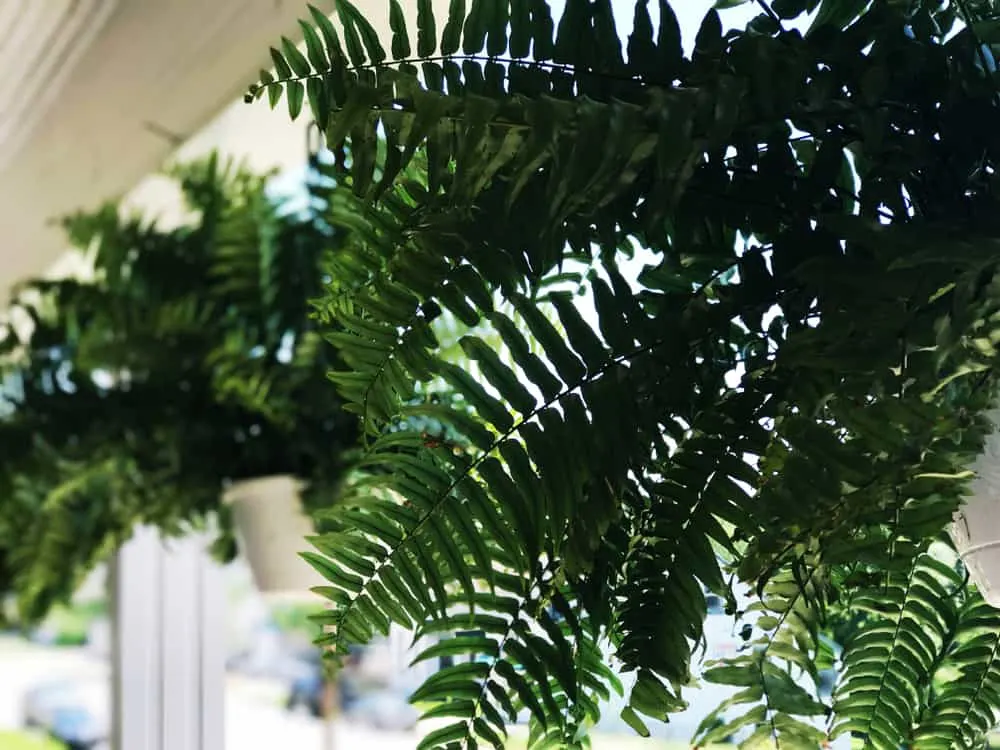
Ferns have grown in popularity over the years, especially as indoor plants. Interestingly, they make charming hanging basket plants, thriving indoors, even during winter where they’re protected from the cold. They’ll keep your space bright and green in the dead of winter.
Most fern varieties have similar needs, including their love for a tiny bit of morning sun, and afternoon shade. They also love high humidity environments, so if you’re hanging your fern indoors, pop a humidifier on. Or, you could make a statement and let your indoor garden flow into the bathroom, where humidity is at its highest.
Ferns need to be planted in a decent potting mix that drains well. Watering requirements depend on the variety of ferns. Most enjoy constantly moist soil, while some prefer soil that dries out before the next watering. No matter the type, good drainage is important as fern roots don’t like to sit in water.
Hanging ferns need to be fertilized once a month during summer and spring with a water-soluble fertilizer. For a healthy fern, opt for a balanced fertilizer.
Approximate size: differs per species
USDA hardiness zone: differs per species
5. Carex
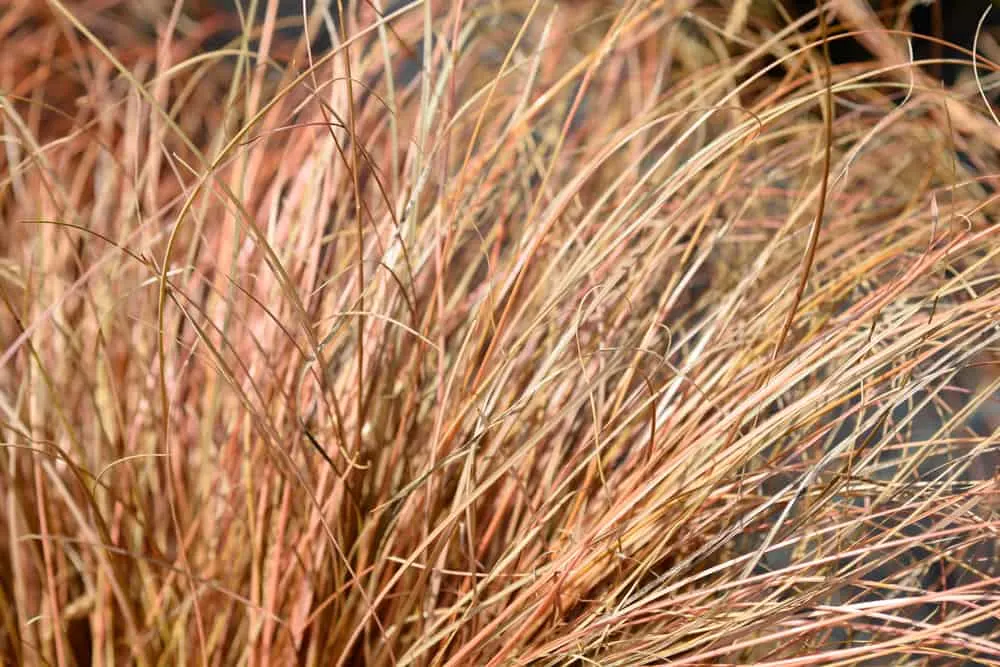
When thinking of hanging plants, flowy, flowering plants come to mind. But a unique take on hanging baskets is to plant ornamental grass. As in gardens, ornamental grasses add a good texture change with their sharp-edged leaves.
Carex is the perfect sweeping grass for your winter hanging basket extravaganza. It’s often used as a filler plant, but their thin leaves arch over the edges of baskets, making them a true standalone plant. During fall, these sharp leaves turn a handsome golden brown, adding a unique break from the greens and summer colors of other plants.
Carex does need a helping hand during winter however, needing some added protection from the cold. Bring your basket indoors and add a layer of mulch as good protection.
This grass prefers constantly moist soil. So, either keep this as a stand-alone hanging basket plant or pair it with plants with the same water needs. Carex thrives in either full sun or shade.
Approximate size: 12 – 16 inches
USDA hardiness zone: 5 – 11
6. Heucheras
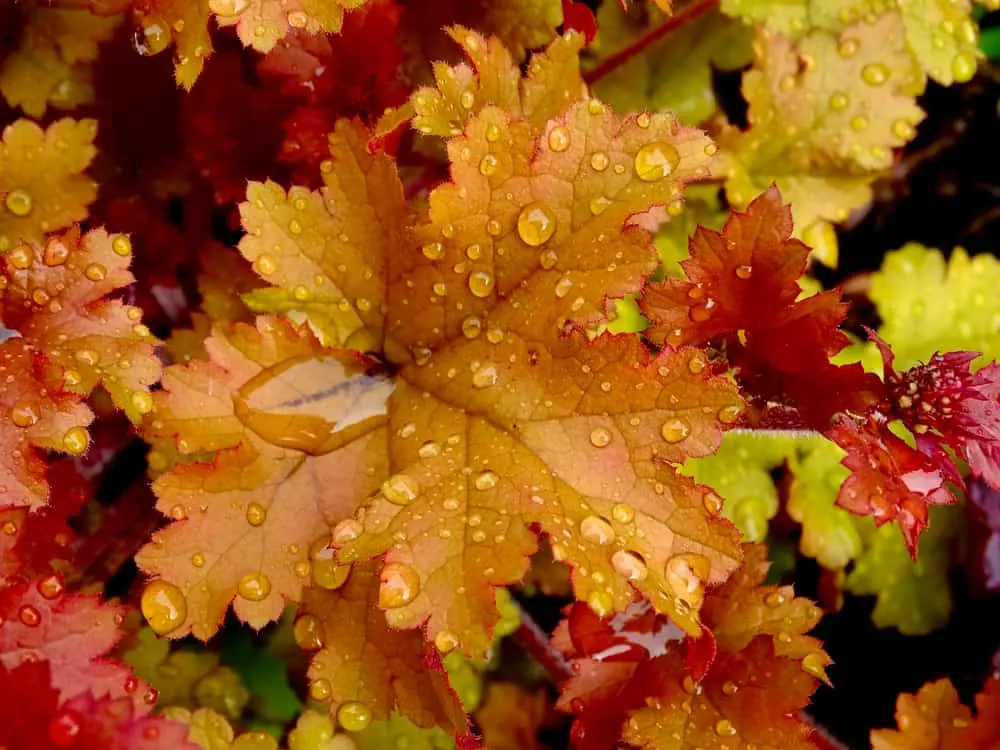
Heucheras, or coral bells as they’re more commonly known, are the perfect plant for those wanting to add color and texture to their space. They’re also low maintenance, making them an even better hanging basket plant.
Coral bells come in a multitude of colors. Their interesting evergreen leaves can either be gold, rose, purple, yellow, or traditional green. Plant coral bells on their own for a striking leafy look, or with other flowering hanging plants.
Heucheras are truly the ideal plant, tolerating most climates. They don’t mind drought, humidity, cold, or heat.
Plant your coral bells in rich, well-draining soil and water frequently during hot, dry spells, otherwise, they’re medium water users.
Approximate size: 6 – 8 inches
USDA hardiness zone: 4 – 9
7. Primulas
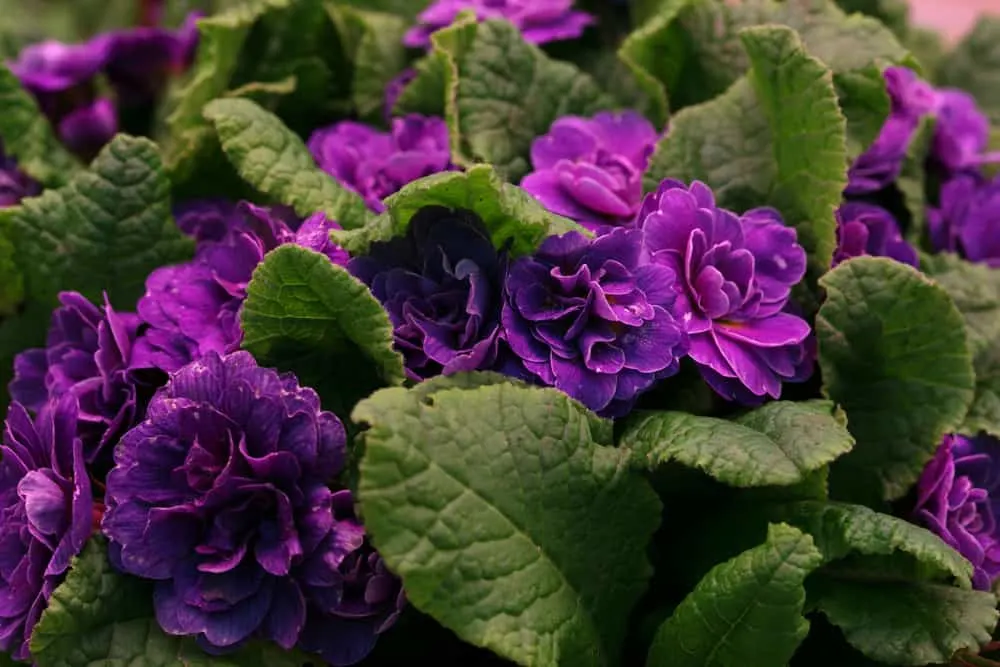
Sometimes simplicity is all you need for a hanging basket display, and primulas offer exactly that. Primulas or primroses aren’t very tall flowering plants, but their colors make up for what they lack. You can get primroses in a multitude of colors, all except green. Over the years, many hybrids have been established, each with its own unique traits and hardiness.
Get the right primula and you’ll be treated with a rainbow of colors during fall and winter. Their shortness allows them to be planted with other plants in your basket. But you can create a ball of color by planting many in one basket.
Primulas prefer partial shade, like morning sun and afternoon shade. They need well-draining moist organic-enriched soil that’s slightly acidic. Primulas are also very thirsty plants, needing water regularly. Be careful not to let the soil get too soggy though. You can add some mulch to help the soil retain moisture.
Approximate size: 6 – 20 inches
USDA hardiness zone: 2 – 8
8. Winter irises
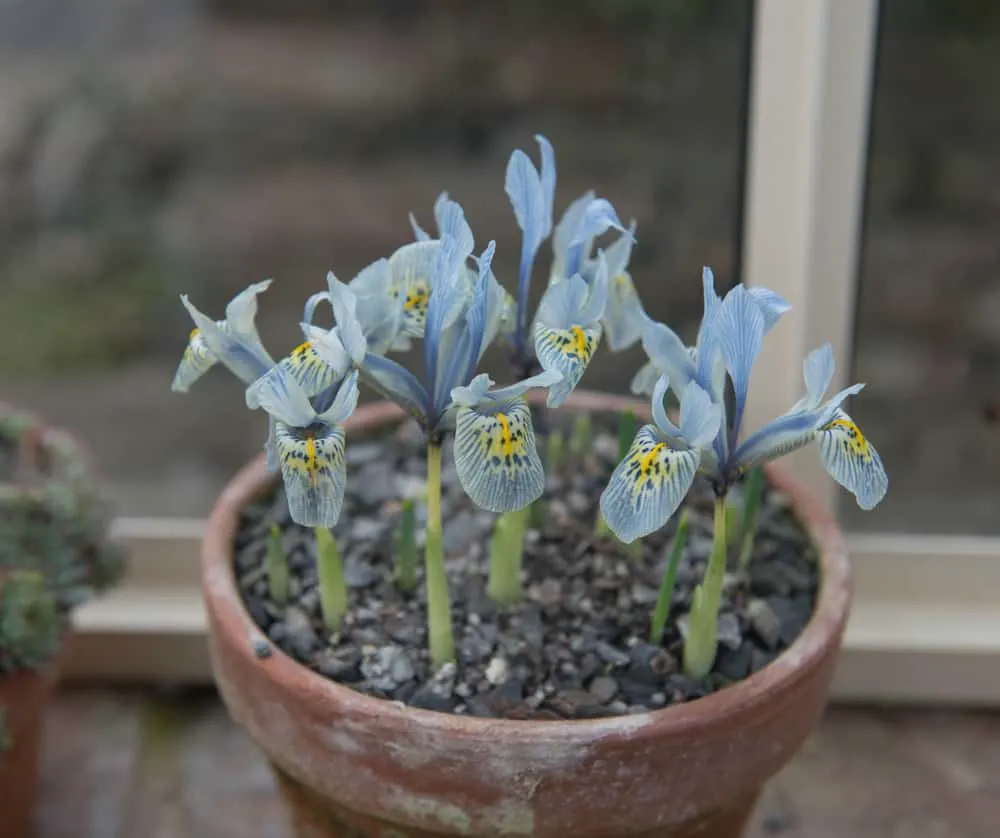
Winter irises offer a flamboyant touch to hanging baskets, no matter where they’re hung. The most sought after is the Algerian iris, which flowers throughout winter. These stout plants have flowers that come in blue, purple, and white – the perfect winter color pallet.
These winter flowers sit amongst the clumps of long slender green leaves. These clumps are generally about 12-18 inches wide, making them perfect for smaller hanging baskets.
Winter irises are easy to care for, needing full sun to really thrive. They’re also relatively drought-tolerant plants, so you won’t be punished for missing a watering or two.
Plant your irises in dry, well-draining soil. Excess moisture in the soil will rot the bulb.
Approximate size: 12 – 18 inches
USDA hardiness zone: 7 – 9
9. Crocus
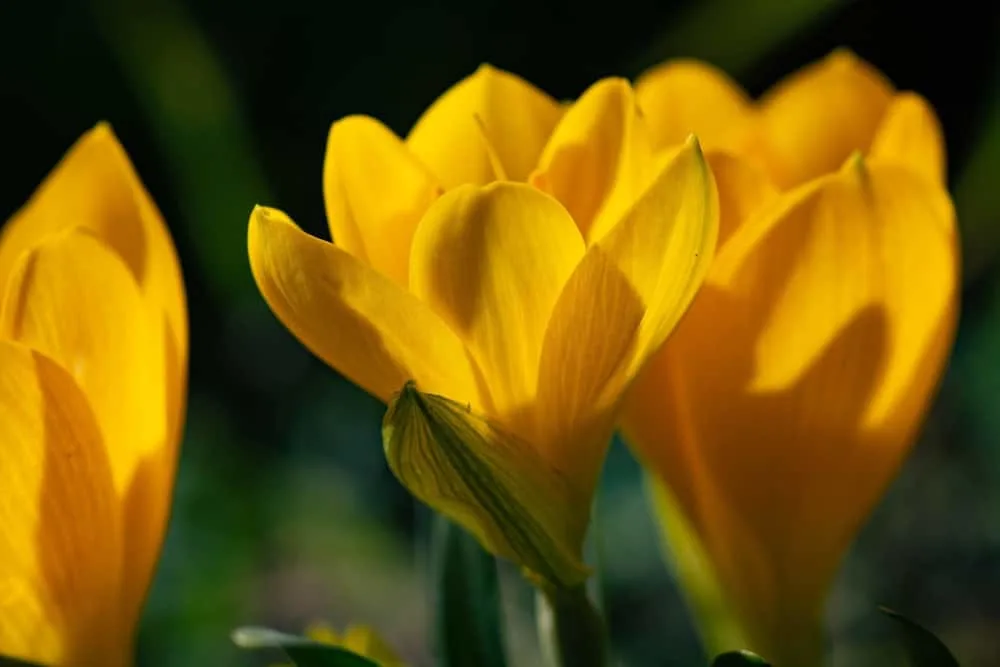
When it comes to winter plants, no list is complete without the mention of crocus. This perennial flowering plant can survive the coldest, harshest winters. Their delicate flowers can withstand the biting cold of frost, maintaining stunning color throughout winter.
Crocus flowers bloom in a variety of pretty colors, including pink, white, purple, and even yellow. There’s nothing like having hints of spring in the middle of gloom. While these colors may not be unique, their shape is the true eye-catcher. The petals bow upwards, forming dainty cups that resemble a many-petalled tulip.
Crocuses need at least six to eight hours of sunlight a day, but they can tolerate some shade. They’ll thrive in well-draining soil and don’t need any additional fertilizer. This easy-to-care-for plant doesn’t need too much water either, enjoying a moderate moisture level. Soggy soil causes rot, while excessively dry soil can cause the plant to die back. A healthy, weekly watering will suit this plant just fine.
Approximate size: 6 – 9 inches
USDA hardiness zone: 4 – 8
10. Snowdrops
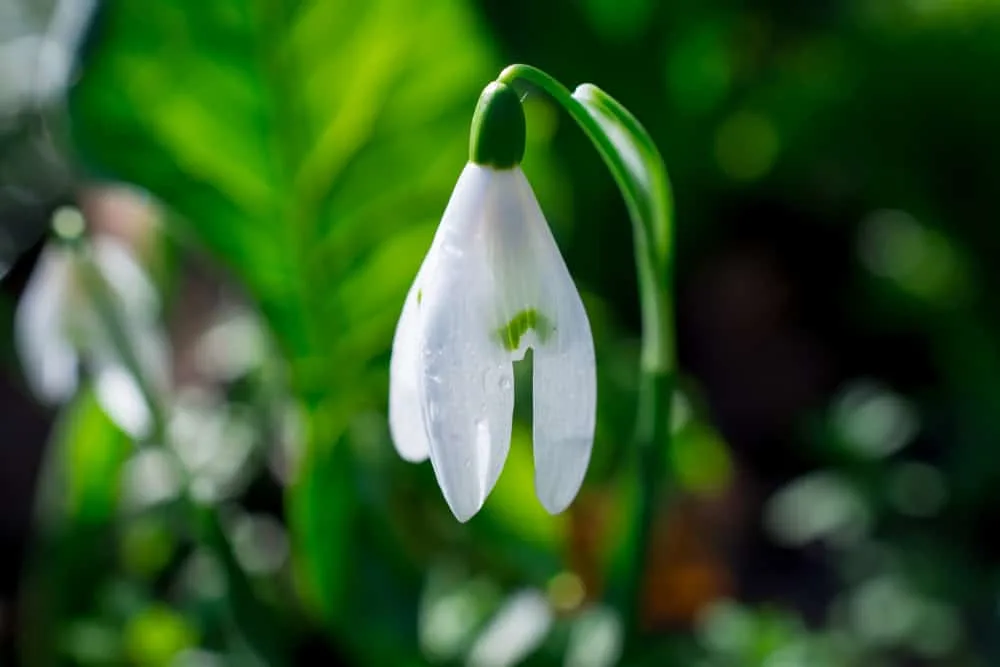
One of the most interesting winter bulbs out there has to be snowdrops. They can bloom as early as fall and through winter. Snowdrops have an interesting superpower, in that they have hard tips, which can push through frozen soil. Their plant cells even have an ‘anti-freeze’ ability where they stay intact no matter how cold it gets. Snowdrops are truly one of the few fantastic winter plants. And, better yet, they look great in hanging baskets.
They make a unique pairing with ivy, where the pretty bulbs won’t be overshadowed. You can also opt to plant many snowdrops in one basket, creating a mini forest of drooping bulbs.
Snowdrops are native to woodland areas and thrive in similar conditions of moistness and dappled light. However, they can grow in bright light. They need organic-enriched soil to flourish and produce winning flowers.
Water your snowdrops well but avoid waterlogging the soil. Ensure your hanging basket has sufficient drainage holes.
Once the bulbs have stopped flowering and the leaves begin to die back, you’ll need to give them a healthy dose of bulb food. This will give them a boost for the next flowering season.
Approximate size: 3 – 6 inches, depending on variety
USDA hardiness zone: 3 – 7
11. Sage
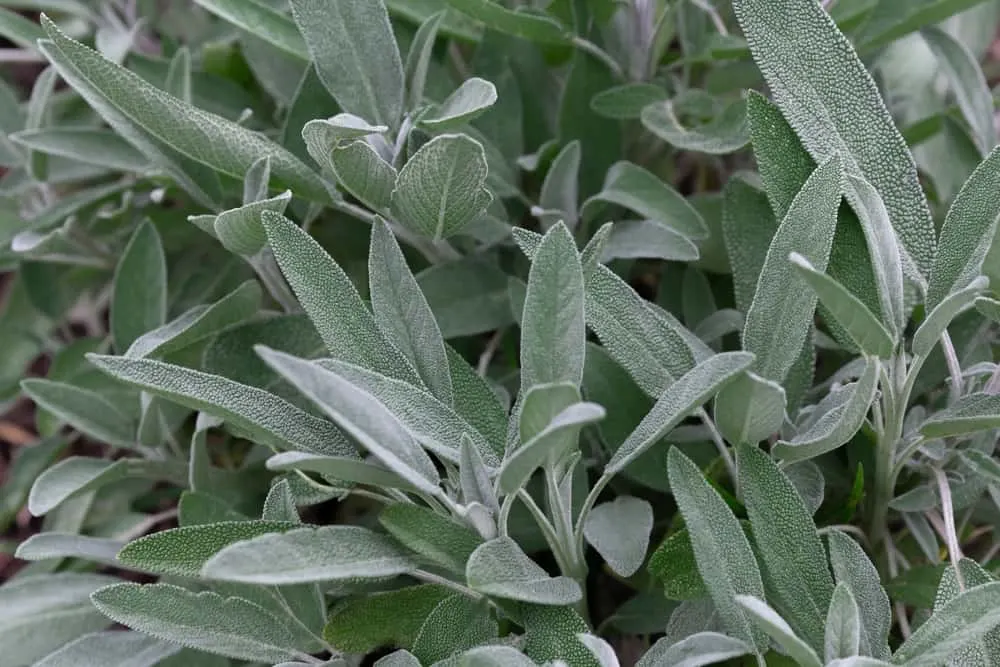
Sage is another unique addition to hanging basket gardens. You can opt for ornamental varieties, whose leaves come in interesting colors and patterns, from dark purple to tricolor. Culinary sage works well in hanging baskets too, plus you get to have fresh sage at your fingertips at all times.
No matter which you choose, you’ll never have to worry about not having color during winter. Sage is an evergreen plant in certain climates, treating your space to its yummy scent, colors, and textures all year round.
Hang your sage in a sunny spot and water it every so often. It’s native to the Mediterranean so it thrives in some of the worst conditions. It’s highly drought tolerant and isn’t fussy about soil as long as it’s well-draining and fast-drying.
Despite its Mediterranian heritage, sage is cold-weather hardy and can survive through the winter. If you experience exceptionally harsh winters, however, it may be a good idea to bring your sage baskets indoors. Keep them near a warm sunny window to keep your sage happy and healthy.
Approximate size: 1 – 3 ft
USDA hardiness zone: 4 – 9
12. Thyme
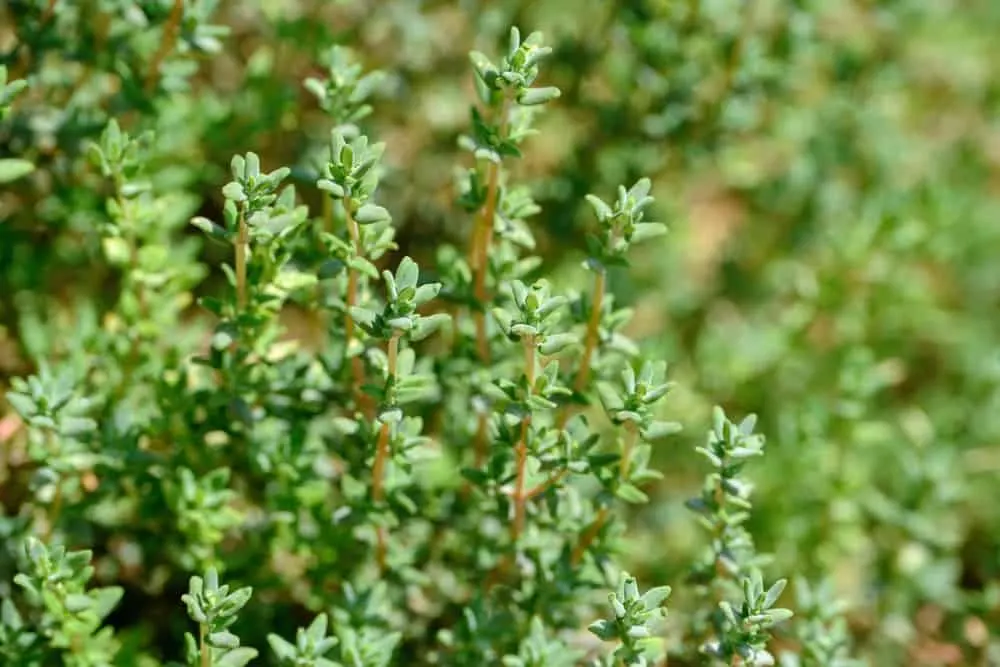
Thyme is another great herb to have in a hanging basket. There are many varieties of thyme to opt for, each with a different scent and taste profile. Golden lemon thyme has lemony scented leaves and caraway thyme smells just like caraway.
Creeping thyme is the perfect choice for those that want a more aesthetically pleasing plant while still reaping the benefits of growing a herb. It fills hanging baskets, and will quickly spill over their edges. During summer, it produces sweet purple flowers, although that’s not why it’s on this list.
Much like sage, it’ll survive the winter depending on your climate, but it’s probably best to bring your thyme basket indoors for some protection.
Thyme is another Mediterranean herb, so it’s quite easy to care for. As long it gets plenty of sunlight and is planted in well-draining soil, your thyme will thrive.
Approximate size: 2 – 12 inches (depending on variety)
USDA hardiness zone: 4 – 9 (depending on variety)
13. Rosemary
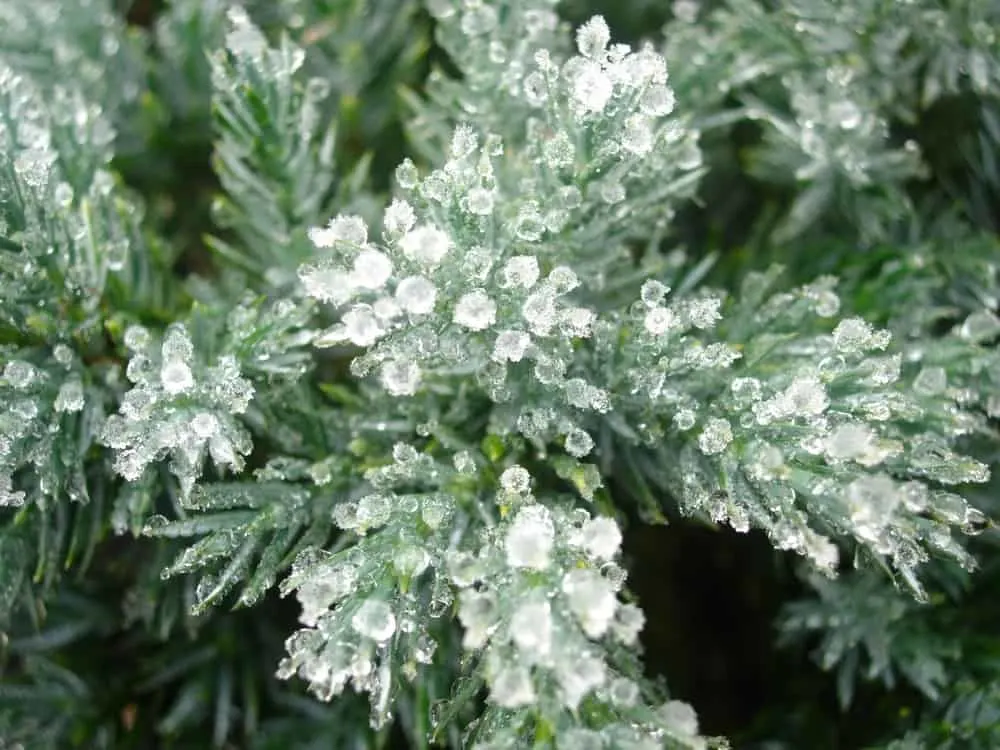
Just like thyme and sage, rosemary makes a different but beneficial hanging plant. Its tall spikiness though makes it an attractive plant while giving you the benefits of growing a herb.
These spikey leaves are evergreen in USDA zones 6-10, so your hanging basket should be brought indoors over winter in colder zones.
Rosemary is also native to the Mediterranean, and so it has very similar needs to both sage and thyme. A normal potting mix that drains well is perfect for rosemary and so long as it receives minimal water and full sun, it’ll thrive.
Related Reading: How To Propagate Rosemary – Step-by-Step with Photos
Approximate size: 2 – 6ft
USDA hardiness zone: 6 – 10
